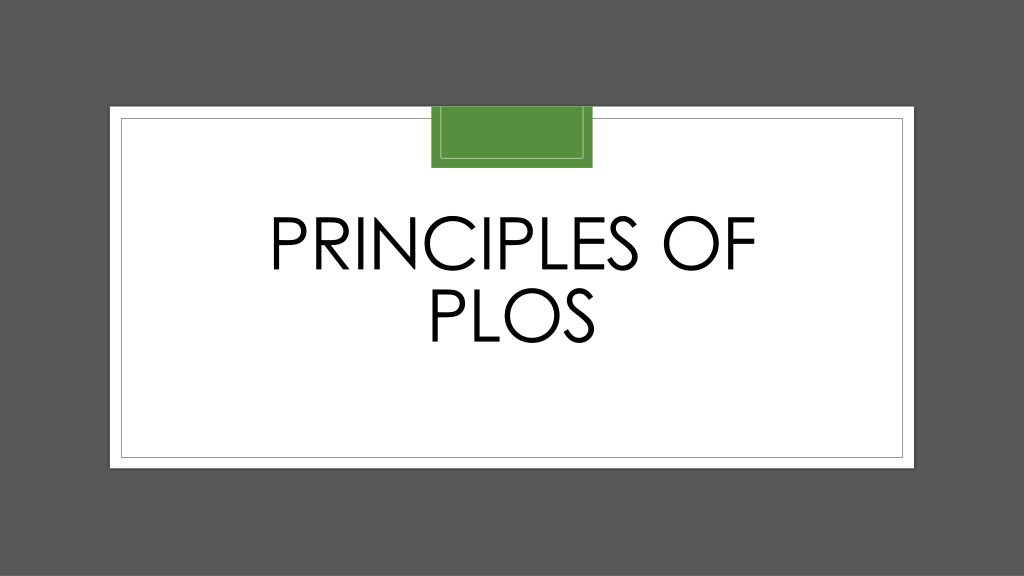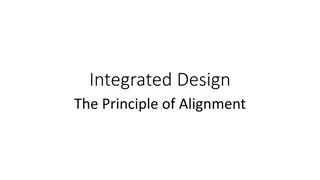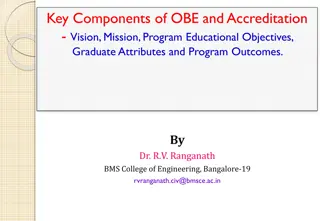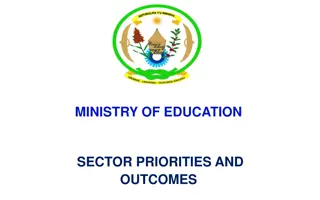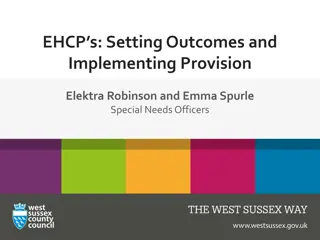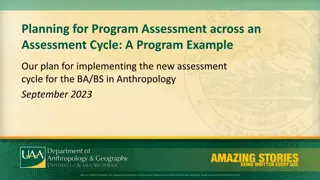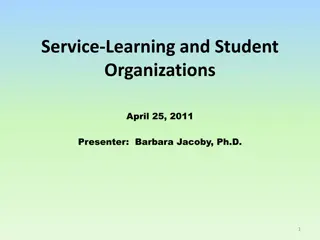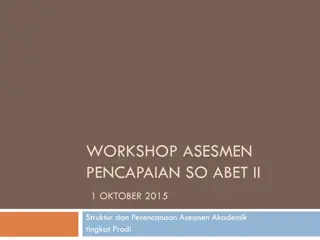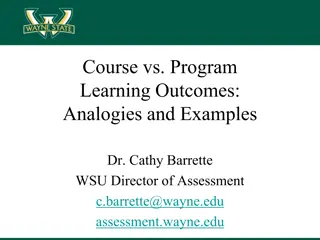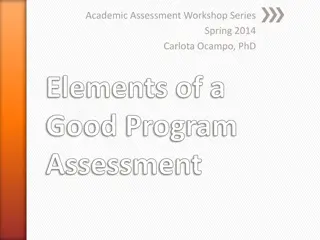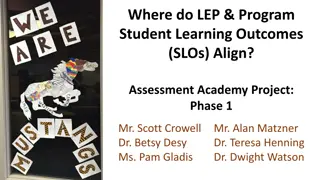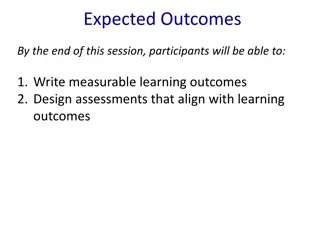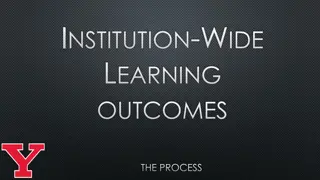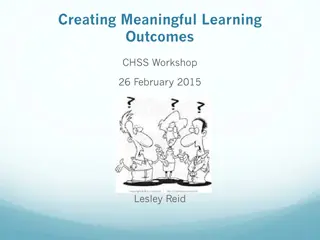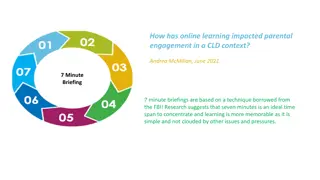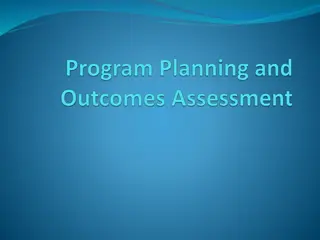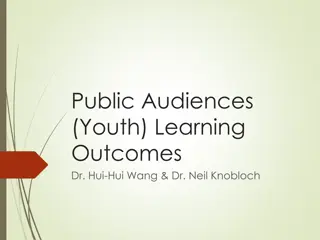Understanding Program Learning Outcomes (PLOs) in Education
Explore the significance of Program Learning Outcomes (PLOs) in educational settings, from defining learning outcomes to the methods of developing and implementing them. Discover how PLOs benefit program planning, curricular assessment, academic advising, institutional cohesion, and accreditation evidence. Learn the principles behind writing clear and assessable PLOs that align with student learning objectives and institutional goals.
Download Presentation

Please find below an Image/Link to download the presentation.
The content on the website is provided AS IS for your information and personal use only. It may not be sold, licensed, or shared on other websites without obtaining consent from the author. Download presentation by click this link. If you encounter any issues during the download, it is possible that the publisher has removed the file from their server.
E N D
Presentation Transcript
PRINCIPLES OF PLOS
Outcome Pyramid How does it all fit together?
What are learning outcomes? GOALS WE SET FOR STUDENT LEARNING INSTITUTIONAL LEARNING OUTCOMES PROGRAM LEARNING OUTCOMES At COD STUDENT LEARNING OUTCOMES OUTCOMES VS. OBJECTIVES
Program Learning Outcomes What are they? Knowledge, skills, and attitudes that a student should have at the completion of a program. What is considered a program A course or series of courses that lead to a certificate or degree. Like SLO s, PLO s should be observable and measurable. Rule of Thumb for the number of PLOs needed Programs leading to a certificate should have 2 PLO s Programs leading to a degree should have 4 PLO s
Why PLOs? Program Planning Program learning goals help faculty plan the curriculum, assess coherence and sequencing, and evaluate the learning of majors. In addition, they signal the program s disciplinary identity and provide a common language that students, faculty, and staff share. Curricular Assessment and Change The assessment of PLOs provides data that takes felt issues in a program and illuminates their realities which provides opportunity for tangible change that benefits students. Institutional Cohesion They can show how each program within the institution relate to each other and fulfill specific student needs. Improved Academic Advising Learning goals for each course are an important first step toward clearly communicating expectations to students and assisting them in matching courses and majors with student interests and capabilities. Evidence for Accreditation They say we gotta.
Writing CLEAR PLOs Cumulative: PLO s should encompass all of the skills and abilities a student would develop through the entirety of the program. Linked: PLO s should be directly tied to course SLO s that lead to the program award and Institutional Learning Outcomes. Exclusive: Be sure your PLO s describe your program specifically. Assessable: Use Bloom s Taxonomy to ensure that PLO s are measurable. Reflect Students: PLO s should communicate what students should be able to do once completing the course.
Methods of Development Begin with Departmental Collaboration Discuss: Foundational courses Capstone course or experience Areas of concentration in the program Required/elective courses A curricular map
Questions to Guide Writing PLOs What should my students be able to do when they ve finished my program? How do my program s courses lead to a finished product? How could I assess this PLO?
Refining PLOs What are the three to five most important outcomes on which you would concentrate? Are your outcomes statements consistent with your statement of purpose and mission? What are the key concepts, change points, capstone courses in your program? Are your outcomes statements specific enough to relate only to your program but not so specific that you need a bunch of them to describe your program? Are your outcomes statements reasonable enough given the ability of your students?
PLO Assessments PLOs can be assessed in many ways Direct assessment Key Assessments, Portfolios, and Capstones. Indirect assessment Review of program data Alumni surveys
Great example of PLOs Compare the following PLO s with the guidelines provided in A Practical Guide to PLO s Advanced First Aid and Safety, CPR/AED (Certificate) Assess victims of injury and medical emergencies and apply an emergency action plan. Demonstrate advanced knowledge, skills, and techniques in Cardiopulmonary Resuscitation and Automatic External Defibrillator # of PLO s appropriate for Certificate program. Outcomes are: Cumulative Linked Exclusive Assessable Reflect Student abilities
Great example of PLOs Compare the following PLO s with the guidelines provided in A Practical Guide to PLO s # of PLO s appropriate for Certificate program. Musical Theater (Certificate) Students will effectively interpret musical theatre scripts and songs. Outcomes are: Cumulative Linked Exclusive Assessable Reflect Student ability Students will integrate interdisciplinary performance skills required for success in the musical theatre field.
Example of PLOs not following best practice guidelines Compare the following PLO s with the guidelines provided in A Practical Guide to PLO s Recommended # of PLO s for degrees 3- 4 Fire Technology (AS Degree for employment Preparation) Outcomes are: Cumulative Not linked to the course Not exclusive to the program Assessable Reflect student abilities Apply critical thinking skills to research, evaluate, analyze, and synthesize information. Display the aptitude and knowledge necessary to qualify for certification exams in their field. General CTE outcomes
Example of PLO not following best practice guidelines Compare the following PLO s with the guidelines provided in A Practical Guide to PLO s # of PLO s appropriate for certificate Integers (Certificate) Help students to develop foundational numeracy skills in integers Outcomes are: Cumulative Linked Exclusive Not Assessable Reflects a teacher focus, not student ability Prepare students with a proper knowledge to be successful in the subsequent math courses.
Reach us at SLO@collegeofthedesert.edu
